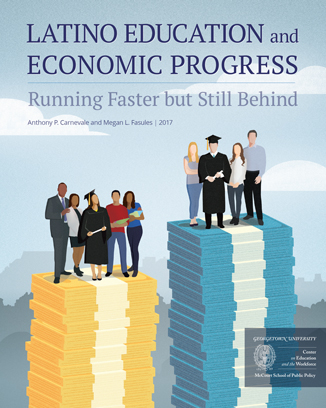Latin Business Today, October 11, 2017 —
Latinos are stalling in the middle tiers of the higher education system and, as a result, are caught in the middle-wage tier of the labor market
WASHINGTON–(CEW Georgetown University)–Earning college degrees remains a challenge for Latinos: only 21 percent of Latinos have bachelor’s degrees compared to 32 percent of blacks and 45 percent of whites.

Center on Education and the Workforce, Georgetown University
Latino Education and Economic Progress: Running Faster but Still Behind, a new study from the Georgetown University Center on Education and the Workforce (Georgetown Center), reveals that lagging college degree attainment has led Latinos to become stuck in the middle-wage tiers of the labor market.
“With access to the right college & career guidance, Latinos can keep running faster toward a promising future.”
“The story of Latino families in America honors an intergenerational striving to achieve full inclusion in our society, and it is their turn,” said Anthony P. Carnevale, director of the Georgetown Center and lead author of the report. “With access to the right college and career guidance, Latinos can keep running faster toward a promising future that awaits.”
While Latinos are running faster in the education race, the researchers found that they are falling farther behind whites and blacks in many crucial college outcomes. Since 1992, Latino postsecondary degree attainment has only increased from 35 percent to 45 percent, a 10 percentage point increase, compared to a 16 point increase for whites and a 22 point increase for blacks. Another reality: 65 percent of Latino students enroll in overcrowded and underfunded community colleges with low graduation rates, while only 15 percent enroll in one of the 500 most selective colleges that have much higher graduation rates.
Even when Latinos obtain college degrees, they are less likely to work in college jobs. Latinos comprise 16 percent of workers, but hold 20 percent of jobs that require no more than a high school diploma. Latinos hold a mere 10 percent of jobs that require at least some postsecondary education, and they hold only 9 percent of jobs which require a bachelor’s degree, and 7 percent of jobs requiring a graduate degree.
The researchers found that in general, Latinos have the lowest earnings compared to whites and blacks. However, when Latinos obtain at least some postsecondary education they have higher earnings than blacks but are still behind whites.
Perhaps the most notable finding reveals that country of origin and English language ability are important sources of wage disparity between whites and Latinos, but they do not fully explain the white-Latino earnings gap. Ultimately, these unexplained differences are owed to differences in access to informal information networks, formal counseling, and other forms of social capital as well as lingering discrimination.
Among major demographic groups, Latina women are the lowest earning group in America. Latina women are typically in low-paying majors, and even when they are in high-paying majors they have lower earnings than Latino men. Latina women need to earn two additional degrees in order to have similar median earnings to white men, and are generally the lowest earning group in America. However, Latina women with bachelor’s degrees outearn black women.
The good news is that, with the right support, Latinos are poised for a surge in educational and economic success.
Latino high school graduation rates have improved the most since the 1990s compared to their white and black peers. Latino first-time enrollees at two- and four-year colleges and universities have also increased—by almost 250,000 students—while white enrollment has actually decreased. Latinos also have the highest completion rates in certificate programs (60 percent), compared to 47 percent for whites and 37 percent for blacks.
In the workforce, Latinos have made the most progress in getting good jobs that require some college but no BA. For Latinos with at least a bachelor’s degree employed in high-wage occupations like those related to science, technology, mathematics, and engineering (STEM), race-based earnings gaps essentially vanish. Both whites and Latinos with either a bachelor’s or graduate degree who work in STEM careers earn $85,000 on average.
“Latino students often start at a disadvantage—many of their parents haven’t gone to college,” said Megan L. Fasules, co-author and research economist at the Georgetown Center. “These students may also have difficulty navigating the financial aid process, so it’s imperative that we close the information gap.”
Other key findings include:
- Latina women have higher completion rates compared to Latino men at every level of postsecondary education.
- While Latinos with high SAT/ACT test scores have similar rates of college enrollment as whites, 63 percent of these Latinos complete a degree or other credential compared to 78 percent of whites with similar test scores.
- Only 34 percent of foreign-born Latinos have some form of postsecondary education compared to 61 percent of native-born Latinos.
- Latinos who speak only English earn $41,000 annually on average, which is lower than whites’ earnings ($50,000) but higher than blacks’ earnings ($38,000).
The full report, Latino Education and Economic Progress: Running Faster but Still Behind, is available online at cew.georgetown.edu/LatinosWorkforce.
The Georgetown University Center on Education and the Workforce is an independent, nonprofit research and policy institute that studies the link between individual goals, education and training curricula, and career pathways. The Georgetown Center is affiliated with the Georgetown University McCourt School of Public Policy. For more information, visit: cew.georgetown.edu.
Research has shown that diversity in the workplace translates into more productivity, efficiency, competitiveness, and innovation. With continuing demographic shifts and structural changes in the economy, embracing diversity is integral to America’s economic competitiveness. At the Center on Education and the Workforce, we champion efforts to increase economic and racial justice in higher education and the workforce. Our commitment stems from a recognition of the disparities in educational attainment and economic opportunity among racial and ethnic minorities, low-income Americans, and women. As America commemorates Hispanic Heritage Month, the Center is proud to celebrate the enduring legacy of Hispanic and Latino culture in the United States. Learn more at cew.georgetown.edu/diversity.











